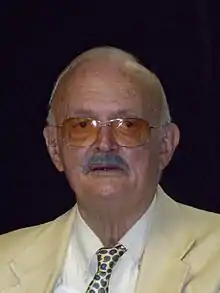Robert Farris Thompson
Robert Farris Thompson (born December 30, 1932, El Paso, Texas[1]) is an American historian and writer specialising in the art of Africa and the Afro-Atlantic world. He has been a member of the faculty at Yale University since 1965 and currently serves as the Colonel John Trumbull Professor of the History of Art.[2] Thompson coined the term "black Atlantic" in his 1983 book Flash of the Spirit: African and Afro-American Art and Philosophy - the expanded subject of Paul Gilroy's book The Black Atlantic.[3]

He lived in the Yoruba region of southwest Nigeria for many years while he conducted his research of Yoruba arts history. He is affiliated with the University of Ibadan and frequented Yoruba village communities. Thompson has studied the African arts of the diaspora in the United States, Cuba, Haiti, Puerto Rico, and several Caribbean islands. Robert Farris Thompson is also an authority on hip-hop culture.
Career at Yale
In 1955, Thompson received his B.A. from Yale University. After receiving his bachelor's degree, he continued his studies at Yale, where he received his Masters in 1961 and his Ph.D in 1965.[4]
Having served as Master of Timothy Dwight College from 1978 until 2010, he was the longest serving master of a residential college at Yale. Thompson is one of America's most prominent scholars of African art,[5] and has presided over exhibitions of African art at the National Gallery of Art in Washington D.C. He is one of the longest-serving alumni of Yale.
Publications and areas of study
Beginning with an article on Afro-Cuban dance and music (published in 1958), Thompson has dedicated his life to the study of art history of the Afro-Atlantic world.[4] His first book was Black Gods and Kings, which was a close reading of the art history of the Yoruba people of southwestern Nigeria (population of approximately 40 million).[4] Other published works include- African Art in Motion, Flash of the Spirit (1983), Face of the Gods, and Tango: The Art History of Love.[4] Thompson also published an introduction to the diaries of Keith Haring. Some of his works have even been translated into German, Portuguese, French and Flemish.[4] Additionally, Thompson also studies the art of Guillermo Kuitca and José Bedia, and has been anthologized 15 times.[4]
Awards
The College Art Association presented its inaugural Distinguished Lifetime Achievement Award for Art Writing to Thompson in 2003,[6] and was named CAA's Distinguished Scholar in 2015.[7] In 2007, Thompson was given the "Outstanding Contribution to Dance Research" award, by the Congress on Research in Dance.
Personal life
Professor Thompson is an active gym goer. He speaks fluently in French, Italian, Portuguese and Spanish and can speak intermediately in Yoruba, Ki-Kongo[8] and Creole.[9] He has been to nearly all 47 countries of Africa and has a sister, two children and four grandchildren.[8]
Bibliography
- 1971 Black Gods and Kings: Yoruba Art at UCLA
- 1974 African Art in Motion: Icon and Act in the Collection of Katharine Coryton White
- 1981 The Four Moments of the Sun: Kongo Art in Two Worlds
- 1983 Flash of the Spirit: African and Afro-American Art and Philosophy
- 1993 Face of the Gods: Art and Altars of Africa and the African Americas
- 1999 The Art of William Edmondon
- 2005 Tango: The Art History of Love
- 2011 Aesthetic of the Cool: Afro-Atlantic Art and Music
References
- Robert Farris Thompson, Flash of the Spirit: African & Afro-American Art & Philosophy (Random House, 1984: ISBN 0-394-72369-4), p. 398.
- "Robert Thompson". Yale University, The Ethnicity, Race, and Migration Program. Retrieved 3 July 2016.
- Valkeakari, Tuire (2009). "Between Camps: Paul Gilroy and the Dilemma of "Race"". In Nyman, Jopi (ed.). Post-National Enquiries: Essays on Ethnic and Racial Border Crossings. Cambridge Scholars Publishing. ISBN 9781443815611.
- "Yale University :: Department of the History of Art". arthistory.yale.edu. Archived from the original on 2015-10-20. Retrieved 2015-10-15.
- "Aesthetic of the Cool: Dr. Robert Farris Thompson in conversation with Dr. Lowery Stokes Sims". The Studio Museum in Harlem. 2011-10-31. Retrieved 2020-08-20.
- "Distinguished Lifetime Achievement Award for Art Writing" (PDF). CAA News. March 2003.
- "Annual Conference | Programs | CAA". www.collegeart.org. Retrieved 2020-08-20.
- Shufro, Cathy (July–August 2010). "Professor of mambo". Yale Alumni Magazine. pp. 2 and 5.
- Iseman, Fred (November 22, 1984). "Robert Farris Thompson: Canons of the Cool". Rolling Stone.
External links
- Portrait page at Timothy Dwight College